The long road to get 'Motorway City' on track with trams
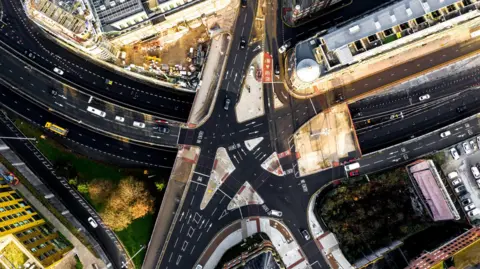 Getty Images
Getty ImagesRegarded as the largest city in western Europe without a mass transit system, Leeds has tried and failed over decades to devise and implement an efficient way to keep its residents mobile. After more than £2bn was pledged for public transport infrastructure in West Yorkshire, we look back at the previous plans which hit the buffers.
Chancellor Rachel Reeves has agreed to fund the construction of a mass transit system connecting Leeds and Bradford
A total of £2.1bn has been pledged for transport projects with promises of "spades in the ground by 2028" and the first trams running in the "early 2030s".
But Leeds has a long history of lines being drawn on maps, endless public consultations and promises of cash – without ever seeing tracks laid.
So will it be different this time?
Underground Metro
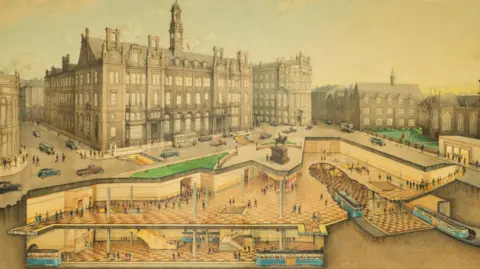 National Tramway Museum
National Tramway MuseumLeeds lost its sprawling tram network in 1959 but, just 15 years earlier, civic planners had been contemplating tunnelling beneath the city centre to create an underground system.
A fascinating drawing from the era shows an extensive passenger interchange below the Black Prince statue in City Square with bright blue trams heading off to destinations such as Roundhay Park, Guiseley and Morley.
But in a war-ravaged economy, other projects took priority. The subway was never built and the trams stayed above ground until their demise at the end of the 1950s.
Leeds did eventually get subterranean transport - in the form of the inner ring road motorway which dives under the city centre.
At the time, urban road schemes were a source of pride and the slogan "Leeds - Motorway City of the Seventies" was even stamped onto envelopes at the Royal Mail's sorting office in the city.
As car ownership grew the roads filled up, average speeds plummeted and the decision to scrap a tram network, much of it running on tracks separated from the road, appeared short-sighted.
MetroLine
 Metro
MetroThe late 1980s saw the first serious attempt to get some form of light rail network back into the city.
In 1988, the Passenger Transport Executive for West Yorkshire - Metro - proposed MetroLine, a new tramway running run from Leeds Town Hall, via Eastgate and Quarry Hill along the A64 to Colton.
"It would have effectively followed the route of the old tram," says Clifford Stead from Leeds Civic Trust.
"It was a simple route that would have put Leeds at the forefront of new tram lines in the UK."
Costed at about £120m, Leeds found itself pitted against Greater Manchester in a race to win approval from Margaret Thatcher's Conservative government.
According to Mr Stead, Leeds lost out because although Metro backed the plan Leeds City Council were lukewarm.
Manchester's Metrolink got the go-ahead and four decades later its bright yellow trams and 65-mile network are synonymous with public transport on the other side of the Pennines.
Leeds Advanced Transit
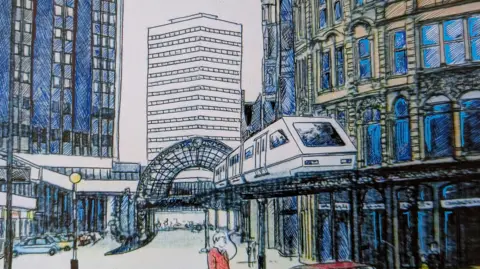 Adrian Spawforth
Adrian SpawforthUndeterred, Leeds formulated a new plan.
If Manchester was getting trams, Leeds would reach that little bit higher.
And so Leeds Advanced Transit (LAT) was born.
Priced at £1bn in 1991, this was a Vancouver-style elevated railway threading its way from Tingley through the city centre to St James's Hospital and Seacroft.
Dismissed as "pie-in-the-sky" by critics, the LAT sank without trace.
Government funds earmarked for the city's sky-train were diverted to Sheffield where the more grounded and cheaper South Yorkshire Supertram won the backing of ministers.
Supertram
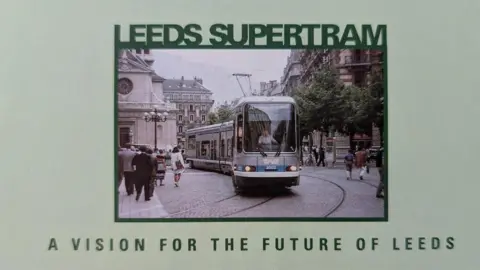 Metro
MetroThe new Labour government elected in 1997 offered fresh hope to Leeds with Deputy Prime Minister John Prescot promising 25 new tram schemes across the country.
Trams were now seen as being a fundamental part of the green transport revolution and in 2001 he gave Leeds Supertram the go-ahead - a £500m three-line network radiating from the city, north towards Headingley, east to Seacroft and south to Middleton and Tingley.
Preparatory works got under way, with diggers excavating land on Great Wilson Street in Hunslet.
But when costs began to rise the government went cool on the project.
Prescott was no longer responsible for transport schemes and his successor, Alistair Darling, pulled the plug, telling Leeds that it would only get funding if it came back with a "bus-based alternative".
New Generation Transport
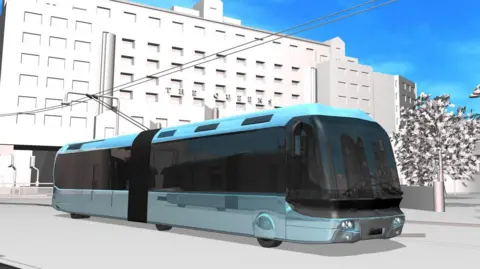 Leeds City Council
Leeds City CouncilAnd so from the ashes of Supertram, the Trolleybus was born.
Dubbed New Generation Transport (NGT) this was an austerity-era attempt to finally get some form of transit system into Leeds.
Electric buses, powered by overhead lines, would run on a route that was partly separated from cars.
Costing £250m, it was substantially cheaper than Supertram but critics said it lacked ambition, while others branded it a costly white elephant, noting that nowhere else in the UK had built a new trolleybus line.
The government rejected NGT after a planning inspector said the scheme was "not in the public interest" and wouldn't "reduce congestion and/or enhance the quality of life in the area it would serve".
In a decades-long game of transport snakes and ladders, Leeds was back at square one again.
Mass Transit
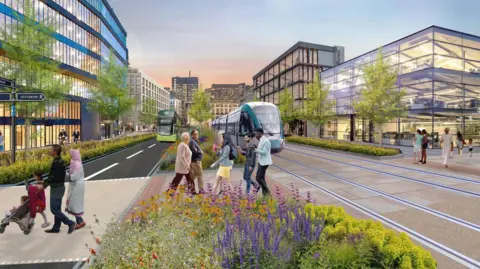 WYCA
WYCACould the latest proposal be the last roll of the dice?
Mass Transit stands out from its predecessors because it reaches beyond Leeds.
Sketched out as a region-wide scheme stretching from Halifax in the west to Pontefract in the east, Mass Transit was distilled down to just two lines costing £2.5bn.
One would serve Leeds, linking the city's two hospitals, the railway station, Elland Road Stadium and the White Rose Shopping Centre.
A second route would head west, taking trams back into Bradford and connecting the city's Interchange and Forster Square railway stations.
Further routes could be added in the future, but initially a balance between long-term ambition and short-term deliverability appear to have influenced the planning.
Tom Forth, an expert in transport data at Open Innovations in Leeds, says that trams work because "they deliver faster and more importantly reliable journey times, so if the tram says it's going to take 28 minutes, and it's separated from the road traffic, it takes 28 minutes, and that's just not the case with buses".
West Yorkshire's Mayor Tracy Brabin says this time it will "absolutely be delivered", vowing that spades will be in the ground in 2028.
But as Supertram showed, even the appearance of workers in high-vis and hard hats doesn't guarantee the arrival of the ever-elusive Leeds tram.
Listen to highlights from West Yorkshire on BBC Sounds, catch up with the latest episode of Look North.
